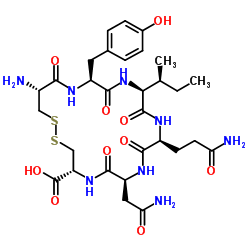Hypothalamic oxytocin mediates adaptation mechanism against chronic stress in rats.
Jun Zheng, Reji Babygirija, Mehmet Bülbül, Diana Cerjak, Kirk Ludwig, Toku Takahashi
Index: Am. J. Physiol. Gastrointest. Liver Physiol. 299(4) , G946-53, (2010)
Full Text: HTML
Abstract
Accumulation of continuous life stress (chronic stress) often causes gastric symptoms. Although central oxytocin has antistress effects, the role of central oxytocin in stress-induced gastric dysmotility remains unknown. Solid gastric emptying was measured in rats receiving acute restraint stress, 5 consecutive days of repeated restraint stress (chronic homotypic stress), and 7 consecutive days of varying types of stress (chronic heterotypic stress). Oxytocin and oxytocin receptor antagonist were administered intracerebroventricularly (icv). Expression of corticotropin-releasing factor (CRF) mRNA and oxytocin mRNA in the paraventricular nucleus (PVN) of the hypothalamus was evaluated by real-time RT-PCR. The changes of oxytocinergic neurons in the PVN were evaluated by immunohistochemistry. Acute stress delayed gastric emptying, and the delayed gastric emptying was completely restored after 5 consecutive days of chronic homotypic stress. In contrast, delayed gastric emptying persisted following chronic heterotypic stress. The restored gastric emptying following chronic homotypic stress was antagonized by icv injection of an oxytocin antagonist. Icv injection of oxytocin restored delayed gastric emptying induced by chronic heterotypic stress. CRF mRNA expression, which was significantly increased in response to acute stress and chronic heterotypic stress, returned to the basal levels following chronic homotypic stress. In contrast, oxytocin mRNA expression was significantly increased following chronic homotypic stress. The number of oxytocin-immunoreactive cells was increased following chronic homotypic stress at the magnocellular part of the PVN. Icv injection of oxytocin reduced CRF mRNA expression induced by acute stress and chronic heterotypic stress. It is suggested that the adaptation mechanism to chronic stress may involve the upregulation of oxytocin expression in the hypothalamus, which in turn attenuates CRF expression.
Related Compounds
| Structure | Name/CAS No. | Molecular Formula | Articles |
|---|---|---|---|
 |
(Ile3)-Pressinoic acid
CAS:34330-23-9 |
C30H44N8O10S2 |
|
The role of oxytocin release in the paraventricular nucleus ...
1996-03-01 [J. Neuroendocrinol. 8 , 163, (1996)] |
|
Prolactin-releasing activity of neurohypophysial hormones: s...
1994-01-01 [Endocrinology 134 , 114, (1994)] |
|
Oxytocin-like peptide: a novel epitope colocalized with the ...
1993-01-22 [Brain Res. 601 , 173, (1993)] |
|
[Effect of arginine vasotocin, oxytocin and their fragments ...
1982-01-01 [Fiziol. Zh. SSSR Im. I. M. Sechenova 68(1) , 112-5, (1982)] |
|
Prolyl-leucyl-glycinamide shares some effects with oxytocin ...
2004-12-15 [Physiol. Behav. 83(3) , 475-81, (2004)] |